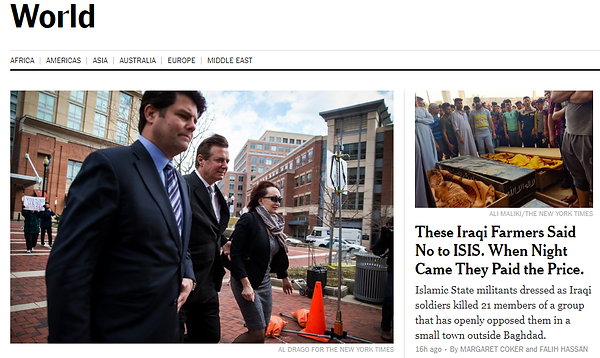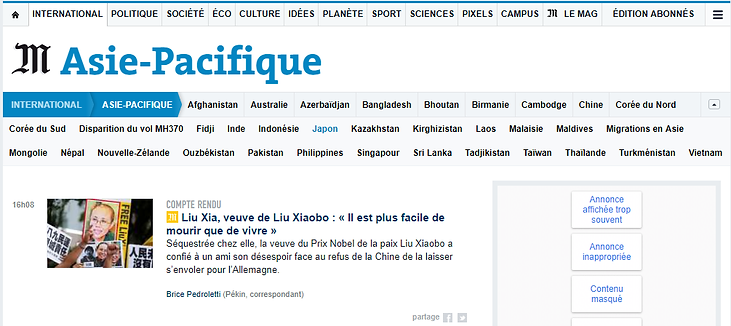Oceania in the media
The term Oceania is not clear, there is no one single definition everybody agrees with. This word is used in very different ways depending on the subject we are looking at. Because of that, and to have a clearer idea about what Oceania can mean, it is important to have a brief look on how media from different parts of the world treat the term. If we focus on American or English media, we will see that the word “Oceania” is not usually used, but things are different when we look at European or Australian news. Despite that, when we look at the international section of different media we will see that the region of Oceania appears under different classifications depending on the newspaper we are looking at, as it can be seen in the following examples.


The New York Times
In this American newspaper based in New York, the section World is divided into: Africa, Americas, Europe, Middle East, Asia Pacific and Australia. Thus, we can see that there is no part of the world considered as Oceania by the NYTimes. Therefore, the news from the regions that made up Oceania are shared in the sections Asia Pacific and Australia in this newspaper. Then, there is also a part of the online edition where you can find another section called “Morning Briefing Asia and Australia edition”.


The Guardian
In the British newspaper The Guardian happens the same than in the American ones, when we look at the international section it’s divided into: Europe, US, Americas, Middle East, Africa, Asia and Oceania. Hence, there is a clear differentiation between the country Australia, which is under Australia section; and other parts of Oceania as New Zealand or Papua New Guinea, that appear into the Asia Pacific section mixed with other countries that are not part of Oceania.

El Mundo
The Spanish newspaper “El Mundo”, is a different case from the ones we have seen before. Here, the international section is in turn divided into five subsections named by the five continents according to the European point of view: America, Asia, Europe, Africa and Oceania. Then, it can be seen that in this newspaper Oceania is considered as a continent, and therefore, news of Australia and New Zealand, Melanesia, Polynesia and Micronesia will appear under the subsection called Oceania, and not divided into Australia, Asia and Pacific groups.


Le Monde
From the point of view of the French “Le Monde”, another European newspaper that can be useful to settle how European media handle with the term Oceania, another perspective is provided. In the online paper we observe that its International section is not divided in continents, but in different random topics (regions like Asia-Pacific, continents as Europe or Africa, topics as defense or diplomacy…) which are in turn classified into subgroups related to the main topic. If we pick Asia and the Pacific, all the countries that are part of this region will appear as subtopics of it. Therefore, the countries that made up Oceania are presented separately in this newspaper (not under any denomination like Australia or Oceania) as equal countries. Hence, even that Le Monde doesn’t treat in a public way Oceania as a continent, it also doesn’t consider Australia as one, as American or English papers do.


The Sidney Morning Herald
Another perspective to bear in mind is the one that comes from Australian media. If we analyze the Australian newspaper The Sydney Morning Herald, it can be seen that it takes into account both terms. On the one hand, the paper is divided into a section called National, whith all the Australian information within it. But on the other hand, there is also another part called World which is in turn divided into different parts of the world: North America, Central America, South America, Europe, Asia, Middle East and Oceania. Thus, and keeping in mind that the division is made into world regions, not continents, we can just know that it considers Oceania as a region. Even there is not a clear definition of what is considered as a continent (if Australia or Oceania), both terms are mostly treated by media in Oceania.


National Geographic
Another example that confirms that there is a big part of American media that treat Australia as a continent is the one shown in National Geographic Society. This organization that was founded in United States, has a specific section in its web where physical geography of Australia and Oceania is explained. In this section both terms Australia and Oceania are handled, and it is shown how National Geographic considers Australia as a continent. Despite that, there is a difference when we talk about this organization. The major part of American or British media that considers Australia as a continent tend to avoid mentioning Oceania in any way, but in this case National Geographic explains in detail the zone, saying that it is a region made up of islands, including the “continent” Australia in it.